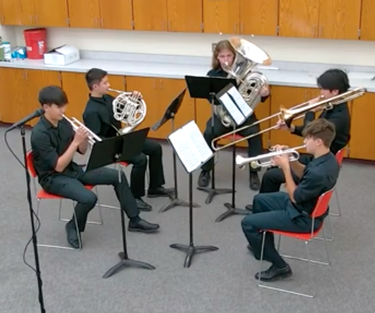GCSD gears up for capital project vote in May 2025
GUILDERLAND — The school board this week heard an update on the task force working to make schools future ready and also heard a presentation on career and technical education in the business department.
Relying on the work underway by a Future Ready Task Force, Guilderland hopes to bring a capital project to vote in May 2025.
The June 11 meeting started with fanfare as the season’s sectional championship teams and state qualifier athletes were lauded and the high school’s brass quintet performed Victor Ewald’s Quintet in B Flat Minor, composed in 1890.
It was the same piece the quintet played in a regional concert of the Chamber Music Society of Lincoln Center’s Young Musicians competition in March, the only group from the Capital Region to perform in the competition, said the high school band director, John Fatuzzo.
At the conclusion of the performance, board President Kelly Person said, “I’d like to make a motion to start every board of education meeting with the music ensemble.”
CTE
Shannon Elliott, the administrator for business, sought and received the board’s approval to pursue renewal of the department’s business management program. The school board agreed to have the paperwork for recertification passed along to the State Education Department.
The business department was approved for a Career and Technical Education pathway by the State Education Department in 2019, Elliott said.
The pathway was created, she said, so that students would have real-life connections with careers and the opportunity for college credit, giving them a competitive advantage.
The three Career and Technical Education pathways approved in 2019 were: accounting and finance, marketing, and business management combined with administration and entrepreneurship.
Although the pandemic intervened, she said, “We kept going …. We held many events. We had our local advisory council meetings.”
This year, the department held its first career and trades fair at the high school for students ninth through 12th grades.
“We tried to create awareness for students to understand what the pathway is … and how they can graduate doing a pathway,” she said.
Although students were taking individual business classes, the program had no “cohort” of students pursuing the pathway, said Elliott.
“We were at a crossroads,” she said, as department leaders asked themselves “Does this have value? Should we continue?”
Elliott also said, “We asked the state if we could get an extension just to see if we can get more people in.” The extension was denied.
The suggestion was made to consolidate the programs into one, creating more flexibility and accessibility for students. “So we created the business management program and it does do all of those things,” said Elliott.
It includes some required courses along with options. An internal review then led to focusing on “the endorsement for the diploma rather than the pathway at this point,” said Elliott, adding, “That may change in the future.”
Now that three different pathways have been combined into one, students have more options.
Currently, Elliott said, “We don’t have anyone who has completed the whole thing … That’s our goal with the consolidation.”
Future ready
Guilderland is on the cusp of forming a District Facilities Committee to map out the district’s next capital project.
It will dovetail with work currently underway by a Future Ready Task Force.
About 50 people volunteered to serve on the task force, which has met three times as a whole, Superintendent Marie Wiles told the board.
Five subcommittees have been formed — for elementary programs; secondary science, technology, engineering, art and math and career skills; secondary humanities; performing arts; and gathering spaces.
The subcommittees, Wiles said, have researched best practices, made site visits at Guilderland and other school districts, surveyed stakeholders, and gathered ideas and information about potential instructional spaces.
Wiles went on, referring to an online survey, “The district also launched a ThoughtExchange to all instructional staff to get input on priorities for future-ready learning spaces.”
CSArch, the district’s architects, Wiles said, “have been terrific and generous” with their time and expertise.
The subcommittees will develop recommendations for their top priorities and then there will be a joint meeting including school board members, members of the task force, and members of the facilities committee in late September or early October.
The facilities committee will be made up of representatives from the district’s bargaining units, the PTA, the school board, and from the community at large. “We’ll do a letter to the editor,” said Wiles, “to reach out to the community.”
She went on, “I think members of the Future Ready Task force should also cross over because they’ve done this work and I think would be strong voices to have on the committee.”
“So everyone can be together and get some good information,” Wiles said. “And then part of this next step is ongoing financial planning with our fiscal advisors.”
That, she said, will answer the question: “What is a reasonable amount to put before the voters in 2025 and down the road?”
The board is to appoint the facilities committee in September and the committee would make its recommendation to the board by February 2025 at the latest so a referendum could be on the May ballot.
Other business
In other business at its June 11 meeting, the Guilderland School Board:
— Applauded Nathan Sabourin who is retiring from the school board after three years.
“Thank you for your time and service to the Guilderland community and our students,” said Wiles as she presented Sabourin with a plaque.
The new terms begin in July but Nina Kaplan, who was elected to the board on May 21, began her term on May 22, to fill a vacancy created when Seema Rivera resigned to become a member of the state’s Board of Regents;
— Approved as a textbook “Pushing the Bear,” a historical novel by Diane Glancy about the Trail of Tears in the 1830s when the Cherokee were forced from their native lands to reservations:
— Heard from Rachel Anderson, superintendent for curriculum and instruction, that 28 students completed the state’s Seal of Biliteracy, established in 2015, to celebrate the multilingualism of English language learners and students completing advanced world language study. The process entailed demonstrating English and world language proficiency through exams, coursework, and a research presentation.
“It was a challenging journey, and we are immensely proud of their achievement,” said Anderson;
— Heard from Sara Berg whose son, Ari Schumann, and husband, Eric Schummann, had addressed the board in May, requesting more spots in advanced tech programs. She wants to “work to find ways” to make spots in Tech Valley High School or the P-TECH program accessible to more students; and
— Heard from Eric Depew who, along with other parents of special-needs students, has spoken to the school board over the last several months.
Depew submitted comments, which were read out loud by Person, listing “several reasonable low-cost or no-cost requests pertaining to our children.”
Depew requested an independent third-party evaluation of the district’s special-education program. Board member Rebecca Butterfield said that the board’s business committee has discussed having an audit of the program.
Depew also wants a group setup to replace “the defunct special-needs PTA” that would allow for open discussion among families of special-needs students, educators, and community members.
He also called for a RACI chart. The acronym stands for responsible, accountable, consulted, and informed and the chart is used for clarifying and defining roles and responsibilities in cross-functional or departmental projects and processes.
Depew asked for the board to address his requests in writing before the end of the school year.
“As it has been months since these initial requests were made, this should not be too much to ask,” Depew concluded.


